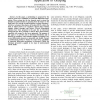Free Online Productivity Tools
i2Speak
i2Symbol
i2OCR
iTex2Img
iWeb2Print
iWeb2Shot
i2Type
iPdf2Split
iPdf2Merge
i2Bopomofo
i2Arabic
i2Style
i2Image
i2PDF
iLatex2Rtf
Sci2ools
IJRR
2006
2006
Force Analysis of Connected Differential Mechanisms: Application to Grasping
In this paper, a methodology is proposed for the analysis of the force capabilities of connected differential mechanisms. These systems are the key elements used to extend the principle of underactuation in grasping from the fingers to the hand itself. The concept of underactuation in robotic grasping-with fewer actuators than degrees of freedom (DOF)--allows the hand to adjust itself to an irregularly shaped object without complex control strategies and sensors. Several technological solutions have been proposed in the past but no theoretical background has been provided to analyze their characteristics, especially with respect to the forces generated. The purpose of this paper is to provide such a theoretical foundation and to illustrate its usefulness with examples applied to grasping. First, several differential elements are presented and studied. Second, a mathematical method to obtain the output force capabilities of connected differential mechanisms is presented. Finally, the te...
| Added | 13 Dec 2010 |
| Updated | 13 Dec 2010 |
| Type | Journal |
| Year | 2006 |
| Where | IJRR |
| Authors | Lionel Birglen, Clément M. Gosselin |
Comments (0)

